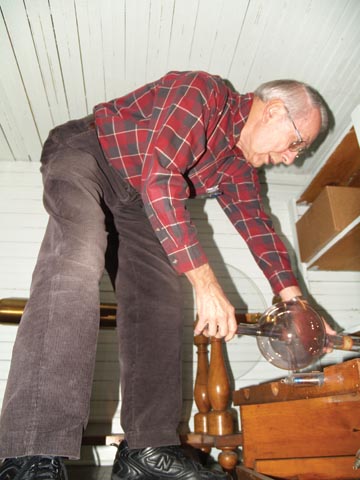| |
|
|

from the issue of March 1, 2007
|

| |
|
|
| |
Emeritus professor restores astronomy, physics instruments

Treasure from the Attic (and a few storage closets)

BY TROY FEDDERSON, UNIVERSITY COMMUNICATIONS
Brandishing a bucket of water and a handful of rags, Eugene Rudd has probed the dark recesses of the Brace Hall attic.

| | 
 
| | | ATTIC FIND - Eugene Rudd examines an X-ray tube in one of the Brace Hall storage closets used to house the Department of Physics and Astronomy Historical Scientific Instrument gallery. hoto by Troy Fedderson/University Communications.

|
Between hand-hewn, century-old rafters, the emeritus physics and astronomy professor has recovered and cataloged rare scientific instruments. A sampling of his finds - some dating back to the building's namesake DeWitt Bristol Brace and the 1880s - are on display in a series of hallway cases scattered through Brace and Behlen halls. The vast majority is stored away in an old classroom storage area converted into a hidden museum in Brace Hall.

"Some of these items have been up there for 50, 60 or 100 years," said Rudd. "It's kind of like a treasure hunt. I used to come in early in the morning before classes start, haul up a bucket and some rags and start cleaning something that looked interesting.

"The cleaning really was a terrible job. But, it was worth it."

Rudd's quest was inspired by his office mate, Duane Jaecks, and fueled by a personal fondness for the history of science.

"I've been interested in the history of science for a long time," Rudd said. "Duane got me interested back in the 1970s when he recognized the historic value of some of the things in the department."

 
| | MUSEUM SPACE - This old Brace Hall storage area, which includes a series of closets on the right, was converted into a museum space for the physics and astronomy equipment refurbished by Rudd. Courtesy photo.

| |
Jaecks had several of the instruments cleaned and restored. Those selections were featured in a 1978 exhibition at the Sheldon Memorial Art Gallery.

However, a career path in atomic physics overshadowed further explorations of the physics and astronomy scientific instrument stashes. It wasn't until retirement that Rudd decided to see just what secrets the old building held.

"Starting in 1998 I collected a large number of the instruments from various storage areas and gave them a preliminary cleaning and started an inventory," Rudd said. "The room where most were kept was repainted and made usable as a sort of museum."

About 750 items are included in Rudd's inventory. The UNL collection includes the simple to the complex - from steam engines and X-ray tubes to electrical instruments invented by Lord Kelvin and spectrograph prisms designed and used by Brace.

"A year or two before I started doing this, inventory destroyed all records for items with a value of under $5,000," Rudd said. "That makes it about impossible to ascertain when an item was purchased. But I've done research in old catalogues and compared pictures to match instruments.

"From that, I've gleaned some small bits of useful information."

About 100 of the items catalogued are available online at http://physics.unl.edu/outreach/histinst/intro.html.

While it consists of obsolete items, the collection continues to be a strong draw for UNL lecturers.

"We have a number of items that are used in lecture demonstrations," Rudd said. "Scientific instruments today are black boxes. They can't show you how something works. But the items in this collection show you how a voltmeter works, you can see the coil and how it rotates and so forth."

While the cataloging process has slowed (a host of interesting, dust encrusted items remain in the Behlen Labs attic), Rudd has turned his attention to passing the collection information on to other scholars. He has presented UNL's Historical Scientific Instrument Gallery collection at conferences around the world. He is also working to include it in an international online registry of scientific instruments being compiled by the History of Science Museum in Oxford, England.

"I'm the unofficial caretaker of this collection, so I'm going to continue to make it available," Rudd said. "These scientific instruments are too interesting to let them be forgotten and discarded again."
GO TO: ISSUE OF MARCH 1
NEWS HEADLINES FOR MARCH 1
Treasure from the Attic (and a few storage closets)
Download ranking prompts reminder
Forum to explore Nebraskans' beliefs on immigration
Real Nebraska fuels Burge's anchor run
Scientists report breakthrough in spin electronics
Women's Week activities begin March 2
732736S36802X
|
|
|
|
|
|
|
|